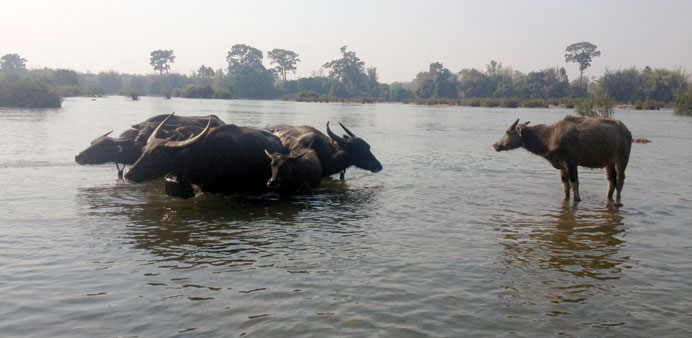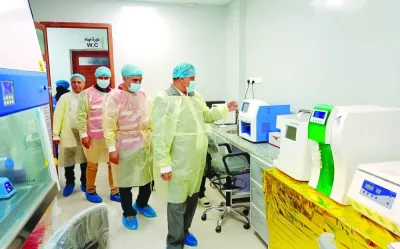* Domesticated water buffalo beat the afternoon heat by wallowing in the cool waters of the Se San River as it runs past Srekor village. The Lower Se San 2 Dam being built several miles downstream will eventually submerge this area as its reservoir behind its 8km-long wall fills.
Fears abound as work starts on controversial hydropower dam. By Robert Carmichael
|
|
For Meach Mean, a veteran campaigner against hydropower dams in Cambodia’s northeast, this year has brought a double dose of bad news. First, he says, two Chinese hydropower companies have begun feasibility studies into a pair of dams planned for tributaries of the Mekong River in the remote northeastern province of Ratanakkiri.
Second, workers last month began clearing an area downstream of those proposed dams for another dam: the 400-megawatt Lower Se San 2, which scientists warn will be the most destructive of dozens planned in the region on tributaries of the Mekong.
Meach Mean, the co-ordinator of the 3S Rivers Protection Network, a non-profit, has no doubt all three dams will be built, and fears the damage they will do to forests, fisheries and the lives of tens of thousands of minority people who will be forced to leave dozens of villages.
“The local communities, and especially the indigenous communities here, will lose their identity because it (is wrapped up) with using the forest and depending on the natural resources,” says Meach Mean, who is himself from an indigenous group.
Cambodia, like much of Southeast Asia, needs more electricity and the region’s governments view hydropower as a logical solution. Yet critics of the Cambodian government, which has earmarked the impoverished and remote northeast for development, complain it is pushing ahead without consulting affected communities.
Campaigners worry the dams will damage food security for millions. Take the Lower Se San 2 Dam: it will be built downstream from the confluence of the Sre Pok River and the Se San River. Consequently its 8-km-long wall will block all migratory fish from accessing breeding grounds in both rivers, says Dr Eric Baran, the senior research scientist at the WorldFish Center, a food security NGO.
Although the Se San and Sre Pok rivers are almost unknown outside the region, they are key tributaries of the Mekong. Together with another river — the Se Kong — they constitute the 3S Basin, which links Cambodia, Laos and Vietnam. These rivers and the Mekong comprise the region’s four “fish highways” and help make the Mekong Basin the world’s richest freshwater fishery.
Baran says the Lower Se San 2 Dam alone will reduce the fish yield of the Mekong Basin by 9.3%. “It’s 9.3% of 2.1mn tonnes, which is a gigantic amount,” he says, adding that migratory fish comprise 40% of all fish in the Mekong Basin.
That makes migratory species a key element of food security in the Mekong Basin, two-thirds of whose 65mn people are reckoned to rely on fish for their diet. Nowhere is that truer than Cambodia, whose population of 15mn eats more freshwater fish per capita than any other in the world.
“People have become very reliant on (fish, which are) also by far the first source of animal protein,” Baran explains. “(Fish) represent 81% of the animal protein consumption in the country.”
Because Cambodia’s livestock sector is far smaller than neighbouring Thailand and Vietnam, the concern is that those affected by reduced fish stocks will find it harder to find replacement work.
Baran’s findings are contained in a hydropower study he co-authored and which appeared last year in the prestigious US science journal PNAS. It assessed regional plans to build 78 dams on tributaries in the Mekong River Basin — which comprises Cambodia, China, Laos, Myanmar, Thailand and Vietnam.
The study concluded that the dams would have “catastrophic impacts on fish productivity and biodiversity” and said a number of them should be reassessed, most obviously the Lower Se San 2 Dam.
Despite that, the Cambodian government is pressing ahead.
Suy Sem, the minister of industry, mines and energy, who is in charge of hydropower, declined to comment until after the July 28 general election and did not reply to written questions. Another senior ministry figure referred all questions to the minister.
Ame Trandem, the Southeast Asia programme director for campaigning group International Rivers, says the Lower Se San 2 Dam should be scrapped. Not only will it harm fish stocks and food security, she says, it will also reduce by up to 8% the flow of nutrients and sediment upon which tens of thousands of subsistence farmers in Cambodia and Vietnam rely to fertilise their fields.
“(The government has) underestimated the importance of the Se San River in maintaining the productivity of the Mekong,” says Trandem. “The dam is a gamble with the future of Cambodia, and one that Cambodia is likely to lose.” – DPA
1) The Se San River looking upstream towards Srekor village. The graveyard stands here on the riverbank around 2km from the village.
2) It is not only forest, farmland and villages that the Lower Se San 2 Dam will flood. Just 2-km downstream from Srekor village stands a graveyard. The bones of local Cambodians who have been cremated are brought to this bamboo grove and placed in small spirit houses like the one in this image. The villagers of Srekor hope the authorities will allow them to take the remains of their ancestors with them when they are forced to leave.
3) Meach Mean, the co-ordinator of the 3S Rivers Protection Network, who says the dams planned or being built in Cambodia’s northeast will inflict significant damage on the lives and livelihoods of tens of thousands of mainly indigenous people.
4) Stacks of wood line the main road running through Srekor village on the banks of the Se San River. The 400 indigenous families living in Srekor village will be forced to move in the next year or so once the reservoir of the controversial Lower Se San 2 Dam floods more than 300sq km of forest, farmland and villages.



